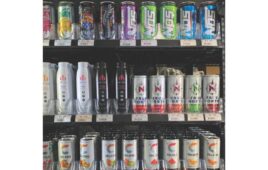Flavored products and natural leaf wrappers remain popular with consumers despite increased taxation and looming FDA intervention.
By Frank Seltzer, Contributing Editor.
Machine-made or mass-market cigars are by far the largest segment of the cigar universe. While premium cigars get most of the notice in magazines and blogs, the reality is that most cigar smokers prefer the cost-effective machine-made cigars by about 95%. More importantly, cigar sales numbers are strong with about 13 billion cigars sold last year—including almost 12 billion large cigars and just under a billion little cigars.
However, the number of cigars sold pales in comparison to cigarettes sales, which topped 315 billion for the same period. While cigar sales do not approach those of cigarettes, they can offer convenience stores better margins. Sales of little cigars have been dropping since 2008 when the number of little cigars hit a peak of nearly six billion. Demand for little cigars was strong in the first quarter of 2009, until the federal State Children’s Health Insurance Program (SCHIP) tax hit little cigars on April 1. At that time, the tax on little cigars jumped from four cents a pack to $1.01 on parity with cigarettes. Sales immediately plunged 60% and that trend has continued. But those figures do not tell the whole story.
As defined by the federal government, a little cigar weighs under three pounds per thousand, uses all tobacco (even the homogenized tobacco leaf wrapper) and, instead of the flue-cured tobacco used as filler in cigarettes, the cigar tobacco needs to be air-cured like the larger premium cigars. Many manufacturers of little cigars knew the SCHIP tax would hit them sooner or later, so they began to reblend their products by adding a bit more tobacco to come in above that three-pound limit, making them what the federal government calls large cigars. Most of these transitions were completed by 2009 when the tax hit. The numbers bear this out in that the number of large cigars jumped by three billion from 2009 to 2010.
Also in 2009, the FDA banned flavored cigarettes, giving the little cigars and large cigars an opportunity to capture that flavored niche. For example, Djarum clove cigarettes were banned under the FDA ruling. The company, like many others, reblended and changed the product to become a filtered cigar while maintaining the flavor profile customers enjoyed. The change from cigarettes, which are inhaled, to filtered cigars, which generally are not, took a while for consumers to adapt to.
Mike Patel, operator of three Five Points Mobil convenience stores in Flagstaff, Ariz., said once his customers got used to the transition, sales have picked up. “The flavored Djarums are selling very well,” Patel said, adding that flavored cigars overall “are picking up big time. Swisher’s peach flavor is my No. 1 seller in little cigars. Customers really like the fruit flavors.”
Playing Within the Rules
The trouble with little cigars and even the cigarillos is that across the country there is a crazy quilt of patchwork definitions. While the federal definition of little cigars remains primarily based on weight at three pounds per thousand, other states and municipalities do not play by the same rules. Industry insiders say there are more than 50 different sets of rules for the little cigars—some of which can even prevent their sale.
Convenience store retailers are expressing a renewed optimism for cigars as the U.S. mass market cigar business posted a strong 49% spike in sales for the first quarter of fiscal year 2011 and has shown rapid growth over the past several quarters, according to UBS analyst David Hallden.
In Montana, for example, the state agrees on the federal weight definition for cigars, but then adds seven other criteria like having a filter or being sold in cartons of 10, which then classifies the product as a cigarette and subjects it to those taxes. It makes life complicated and industry insiders told CSD that the answers they are getting from government officials about little cigars can vary depending upon which official is giving the answer within a state.
Some states have applied cigarette taxes to the little cigars without changing the classification, while others like Pennsylvania and New York, have upped the weight limit on little cigars to four pounds per thousand, and Minnesota is talking about raising it to 4.5 pounds. In addition, Pennsylvania has added an “other tobacco” tax to little cigars. In the past, the state didn’t tax cigars.
Robert Perkins, vice president of marketing for 56 Rutter’s Farm Stores in York, Pa., said sales of little cigars have been hit because of that tax increase. In the Midwest, John Archer, a Shell-branded marketer in Hindsdale, Ill., moved his cigars behind the counter last year and said the decision has impacted his sales.
But not everyone is having those problems. Naser Nayeb, operator of eight Shop and Go stores in Garland, Texas, said that flavored little cigars like Dean’s or Supreme Blend are really moving in his market. “As a whole, we are doing extremely well with the little cigars,” he said. “But the flavored machine-made cigars are doing the biggest numbers, and the original Swisher Sweets is our top seller.”
While declining to give specifics, Catherine Huggins of Iowa-based Kum and Go said the company’s 430-plus stores in 11 states are doing very well in the cigar category and plans to focus on flavored products for the balance of 2011.
Tobacco consultant Lou Maiellano, president of TAZ Marketing, is expecting to see solid growth in the flavored market throughout 2011. The wild card remains FDA intervention. However, any FDA legislation of cigars is still viewed as several years away.
In the meantime, Maiellano said, customers are migrating to cigars. A recent study by research company Mintel International shows that about half of cigarette smokers who have not already tried cigars are interested in pursuing that smoking option, which could add more to sales.




